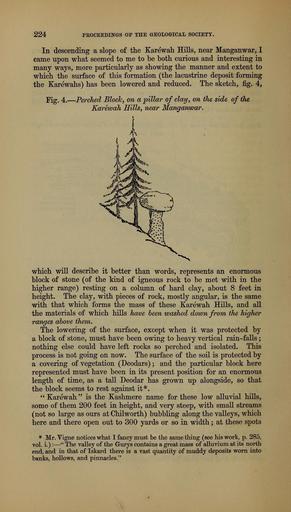MAKE A MEME
View Large Image

| View Original: | The_Quarterly_journal_of_the_Geological_Society_of_London_(12981404434).jpg (1162x2045) | |||
| Download: | Original | Medium | Small | Thumb |
| Courtesy of: | commons.wikimedia.org | More Like This | ||
| Keywords: The Quarterly journal of the Geological Society of London (12981404434).jpg 224 <br> PEOCEEDINGS OF THE GEOLOGICAL SOCIETY <br> In descending a slope of the Karewah Hills near Manganwar I <br> came upon wliat seemed to me to be both curious and interesting in <br> many ways more particularly as showing the manner and extent to <br> which the surface of this formation the lacustrine deposit forming <br> the Karewahs has been lowered and reduced The sketch fig 4 <br> Fig 4 ” Perched Block on a pillar of clay on the side of the <br> Karewah Hills near Manganwar <br> which will describe it better than words represents an enormous <br> block of stone of the kind of igneous rock to be met with in the <br> higher range resting on a column of hard clay about 8 feet in <br> height The clay with pieces of rock mostly angular is the same <br> with that which forms the mass of these Karewah Hills and all <br> the materials of which hills have been washed down from the higher <br> ranges above them <br> The lowering of the surface except when it was protected by <br> a block of stone must have been owing to heavy vertical rain-falls ; <br> nothing else could have left rocks so perched and isolated This <br> process is not going on now The surface of the soil is protected by <br> a covering of vegetation Deodars ; and the particular block here <br> represented must have been in its present position for an enormous <br> length of time as a tall Deodar has grown up alongside so that <br> the block seems to rest against it <br> Karewah is the Kashmere name for these low alluvial hills <br> some of them 200 feet in height and very steep with small streams <br> not so large as ours at Clulworth bubbling along the valleys which <br> here and there open out to 300 yards or so in width ; at these spots <br> Mr Vigne notices what I fancy must be the same tiling see his work p 285 <br> vol i ” The valley of the Gm-ys contains a great mass of alluvium at its north <br> end and in that of Iskard there is a vast quantity of muddy deposits worn into <br> banks hollows and pinnacles 36161767 111474 51125 Page 224 Text v 15 http //www biodiversitylibrary org/page/36161767 1859 Geological Society of London Biodiversity Heritage Library The Quarterly journal of the Geological Society of London v 15 1859 Geology Periodicals Smithsonian Libraries bhl page 36161767 dc identifier http //biodiversitylibrary org/page/36161767 smithsonian libraries Information field Flickr posted date ISOdate 2014-03-07 Check categories 2015 August 26 CC-BY-2 0 BioDivLibrary https //flickr com/photos/61021753 N02/12981404434 2015-08-26 14 51 47 cc-by-2 0 PD-old-70-1923 The Quarterly journal of the Geological Society of London 1859 Photos uploaded from Flickr by Fæ using a script | ||||